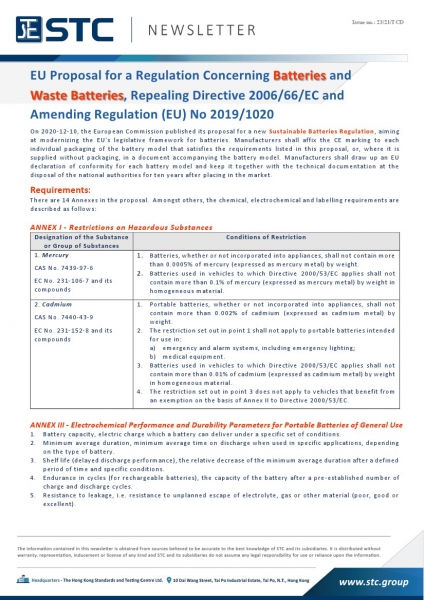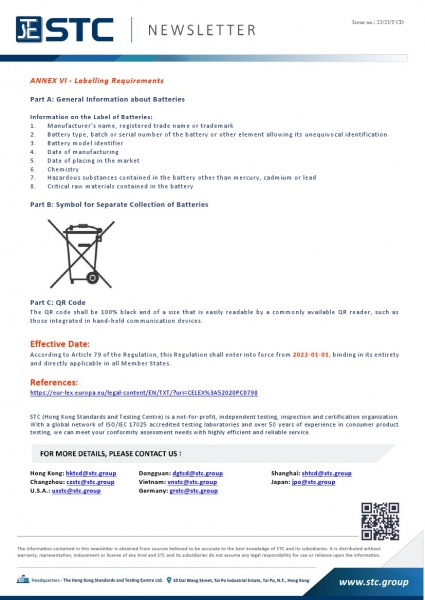
EU Proposal for a Regulation Concerning Batteries and Waste Batteries, Repealing Directive 2006/66/EC and Amending Regulation (EU) No 2019/1020
On 2020-12-10, the European Commission published its proposal for a new Sustainable Batteries Regulation, aiming at modernizing the EU's legislative framework for batteries. Manufacturers shall affix the CE marking to each individual packaging of the battery model that satisfies the requirements listed in this proposal, or, where it is supplied without packaging, in a document accompanying the battery model. Manufacturers shall draw up an EU declaration of conformity for each battery model and keep it together with the technical documentation at the disposal of the national authorities for ten years after placing in the market.
Requirements:
There are 14 Annexes in the proposal. Amongst others, the chemical, electrochemical and labelling requirements are described as follows:
ANNEX I - Restrictions on Hazardous Substances
1. Mercury
- Batteries, whether or not incorporated into appliances, shall not contain more than 0.0005% of mercury (expressed as mercury metal) by weight.
- Batteries used in vehicles to which Directive 2000/53/EC applies shall not contain more than 0.1% of mercury (expressed as mercury metal) by weight in homogeneous material.
2. Cadmium
- Portable batteries, whether or not incorporated into appliances, shall not contain more than 0.002% of cadmium (expressed as cadmium metal) by weight.
- The restriction set out in point 1 shall not apply to portable batteries intended for use in:
a) emergency and alarm systems, including emergency lighting;
b) medical equipment.
- Batteries used in vehicles to which Directive 2000/53/EC applies shall not contain more than 0.01% of cadmium (expressed as cadmium metal) by weight in homogeneous material.
- The restriction set out in point 3 does not apply to vehicles that benefit from an exemption on the basis of Annex II to Directive 2000/53/EC.
ANNEX III - Electrochemical Performance and Durability Parameters for Portable Batteries of General Use
1. Battery capacity, electric charge which a battery can deliver under a specific set of conditions.
2. Minimum average duration, minimum average time on discharge when used in specific applications, depending on the type of battery.
3. Shelf life (delayed discharge performance), the relative decrease of the minimum average duration after a defined period of time and specific conditions.
4. Endurance in cycles (for rechargeable batteries), the capacity of the battery after a pre-established number of charge and discharge cycles.
5. Resistance to leakage, i.e. resistance to unplanned escape of electrolyte, gas or other material (poor, good or excellent).
ANNEX VI - Labelling Requirements
Part A: General Information about Batteries
Information on the Label of Batteries:
1. Manufacturer’s name, registered trade name or trademark
2. Battery type, batch or serial number of the battery or other element allowing its unequivocal identification
3. Battery model identifier
4. Date of manufacturing
5. Date of placing in the market
6. Chemistry
7. Hazardous substances contained in the battery other than mercury, cadmium or lead
8. Critical raw materials contained in the battery
Part B: Symbol for Separate Collection of Batteries (See PDF)
Part C: QR Code
The QR code shall be 100% black and of a size that is easily readable by a commonly available QR reader, such as those integrated in hand-held communication devices.
Effective Date:
According to Article 79 of the Regulation, this Regulation shall enter into force from 2022-01-01, binding in its entirety and directly applicable in all Member States.
References:
https://eur-lex.europa.eu/legal-content/EN/TXT/?uri=CELEX%3A52020PC0798
[See PDF version for more information]











